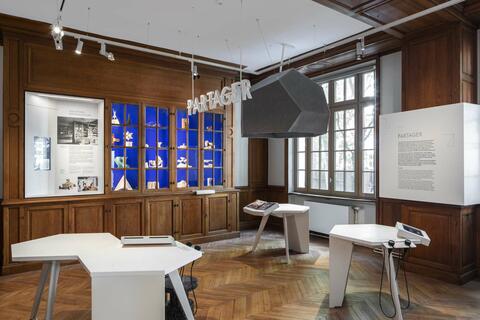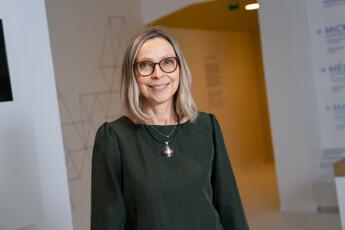
The Maison Poincaré, the first museum in France entirely dedicated to mathematics
An interview with Sylvie Benzoni, mathematicien and director of the Henri Poincaré Institute (IHP).

Sylvie Benzoni, mathematician and director of the Institut Henri Poincaré (IHP), talks about the aims and history of this museum, which is hosted and managed by Sorbonne University. The Maison Poincaré is located at the heart of the IHP, an international research center in mathematics and theoretical physics under the auspices of Sorbonne University and the CNRS.
How and when was the Maison Poincaré created?
Since the late 1980s, the IHP has had a threefold mission: to foster scientific exchange and interaction at an international level, to provide researchers with access to high-level scientific documentation, and to encourage dialogue between science and society.
On the occasion of the IHP's twentieth anniversary in 2014, Cédric Villani and Jean-Philippe Uzan, then director and deputy director of the Institute, announced its extension to the building of the physical chemistry laboratory founded by Jean Perrin, winner of the 1926 Nobel Prize in Physics. The Maison Poincaré is part of this extension project, with the ambition of rehabilitating this space steeped in history as a place for scientific exchange and housing a mathematics museum.
Sorbonne University made the Perrin building available and the CNRS pledged their support in 2014 for the project, financed by a 14 million euro joint contract from the State and the Region. The IHP endowment fund was created in 2016 by Sorbonne University, the CNRS, learned societies and the Cercle des entreprises partenaires to raise private funds for this project to bring together the general public and the world of research. Thanks to the fund's partners (companies and philanthropists), we were able to finance the museographer and the large Rulpidon, a geometric sculpture over two meters high created by Ulysse Lacoste.
Tell us about the architectural and museographic ambitions of this five-year renovation project.
When I took over as director of the IHP in 2018, the Physical Chemistry, Matter and Radiation laboratory was housed in the Perrin building, before moving to the Pierre and Marie Curie campus, and the laboratory had therefore been emptied. The architectural competition for the rehabilitation of the building selected Atelier Novembre with the scenography agency du&ma. The basis for the museum was of course the IHP's collection of mathematical objects, but there were no concrete plans. Everything remained to be done. It was dizzying.
As early as 2018, we called on the members of the Comité de culture mathématique (the Mathematics Culture Committee), a think tank for actions for the general public, to set up working groups on the content of the museum's various spaces. We involved everyone with an interest in the project. This collective work, involving museographer and physicist Céline Nadal, the du&ma agency for the scenography, and dozens of volunteers from research, teaching and mediation, gave rise in March 2019 to a detailed museographic program.
It was a real challenge for the architects to create functional, modern spaces that met comfort and accessibility standards, in the heritage setting of the Perrin building. The project mobilized teams from Sorbonne University and the IHP for almost five years, at a cost of nearly 17 million euros.
What are the challenges and objectives of this research-based museum?
The museographic tour and the content of the exhibits have been designed in collaboration with researchers to present mathematics in all its diversity, creativity, humanity and openness to the world. The aim is to inspire young people to take an interest in mathematics, to ask themselves questions and, why not, to inspire others to follow in their footsteps. In other words, the challenge is to provide a modern, accessible and inclusive vision of mathematics as a vast and living science, in constant interaction with other sciences and society.
To achieve this, the researchers tackled themes and issues that affect society, everyday objects and problems, using a variety of media: videos, films, books, games, manipulations, multimedia and interactive devices. They have contributed their ideas, knowledge and expertise, as well as documentary content, taking part in interviews or creating prototypes for manipulations. Today, 14 ambassadors, including mathematician Nathalie Ayi, a lecturer at Sorbonne University, continue to support the museum's ambitions and objectives, and to give an embodied image of mathematics for its opening.
What will we see in the museum?
On two floors of the Perrin building, the Maison Poincaré houses a permanent exhibition, a temporary exhibition space and a large room for mediation activities, while the other floors of the building are reserved for the scientific teams and activities hosted by the IHP. Spanning more than 600m2, the permanent exhibition route comprises seven spaces, all designed around an action verb.
The Connect space, for example, gives an overview of the fields and sub-fields of mathematics, using everyday objects. The Devenir (Become) section presents inspiring models of mathematicians, showing the variety of their professions and commitments. In the Modeling section, you'll discover some mathematical applications in a wide variety of fields. In the Visualize area, the Holo-Math mixed reality experience lets visitors discover and interact with mathematical objects and concepts as if they were an integral part of an immersive narrative journey. The Maison Poincaré is thus the first museum to offer a collective mixed-reality activity. The Share space shows how mathematical objects have inspired a number of artists: sculptors, painters, photographers... You can lull yourself into mathematical language, or listen to short stories based on the tales of our mathematicians.
What kind of public is the museum designed for?
By 2026, we hope to welcome 30,000 visitors a year, including 20,000 schoolchildren, 50% of whom will come from priority schools in the Île-de-France region, with the ambition of receiving up to four classes a day.
We have designed the permanent exhibition to be accessible to young people from the fourth grade upwards, a level of education that includes the vast majority of adults. Schoolchildren, whom we want to inspire to take an interest in mathematics and science in general, are our prime target audience. A modular offer has been designed to give teachers the opportunity to build a visit that suits them.
We work in partnership with Sorbonne University's Maison pour la science (The Science House) to provide guided tours for primary and secondary school teachers, as well as students studying for this profession. We have also launched a partnership with the city of Créteil public schools to bring in students who are less likely to imagine themselves studying mathematics.
Finally, in the interests of inclusion, we wanted to offer the best possible accessibility to people with motor, visual and hearing disabilities, by creating specific itineraries, information sheets and labels in relief and Braille, models, subtitled videos and videos translated into sign language. One regret is not having succeeded in making the amphitheater chair accessible to wheelchair users.
You've opted for in-person guides. Why is this important?
It's a real challenge to bring the IHP's scientific community into dialogue with the general public. That's why we opted for actual people as guides, to go further than a self-guided tour. This type of mediation is particularly important for a scientific theme like mathematics, which requires explanation, reflection and bridging between different notions. Through Sorbonne University, we benefit from the Science with and for Society (SAPS) label, which has enabled us to recruit a facilitator for class and group visits.
Gender parity is central to the tour. Why do you think this is so important?
The proportion of women in the university mathematical and computing community has stagnated at around 20% for decades, and still too few young women go on to study mathematics. The weight of stereotypes conveyed since elementary school plays a powerful role in career choices. It is therefore essential to take action to deconstruct them.
We wanted to compensate for the fact that the history of mathematics has mainly retained only men, by choosing a representation of equal representation, as an aspiration of what the mathematical world should be. To this end, we have endeavored to present as many portraits of women as of men throughout the tour, be they video, audio or photo portraits, of historical or current personalities. Our aim was not to present a pantheon of the best mathematicians, but a diversity of inspiring life stories with which young people, both boys and girls, can identify.
As well as the permanent exhibition, other events are planned throughout the year, aren't they?
Meetings, conferences, screenings, debates and ephemeral art installations will bring the space to life all year round, including at night. Temporary exhibitions will revolve around a theme linked to current events or societal concerns. Portrait exhibitions will pay tribute to events, eras or great scientific figures. Hands-on workshops will also be organized for children.
Last but not least, the Maison Poincaré will welcome artists from a variety of backgrounds, such as digital artist Kaspar Ravel, currently in residence at Sorbonne University.
Embark on a guided video visit! (English subtitles are available)
Vivez l'expérience de la Maison Poincaré





